介词on、in、at 的用法
- 格式:doc
- 大小:19.00 KB
- 文档页数:3
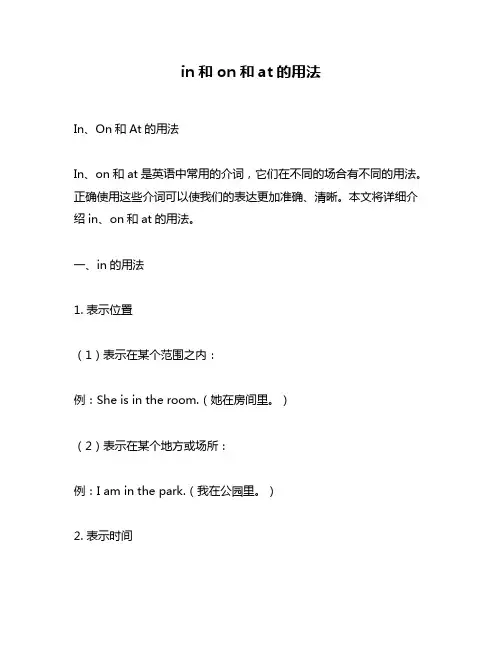
in和on和at的用法In、On和At的用法In、on和at是英语中常用的介词,它们在不同的场合有不同的用法。
正确使用这些介词可以使我们的表达更加准确、清晰。
本文将详细介绍in、on和at的用法。
一、in的用法1. 表示位置(1)表示在某个范围之内:例:She is in the room.(她在房间里。
)(2)表示在某个地方或场所:例:I am in the park.(我在公园里。
)2. 表示时间(1)表示季节、月份、年份等长时间段:例:I was born in 1990.(我出生于1990年。
)(2)表示一天中的具体时间段:例:I always have breakfast in the morning.(我总是在早上吃早餐。
)3. 表示状态或情况(1)表示身体或精神状态:例:She is in good health.(她身体很健康。
)(2)表示情感状态:例:He is in love with her.(他爱上了她。
)二、on的用法1. 表示位置(1)表示在物体表面或靠近物体表面:例:The book is on the table. (书放在桌子上。
)(2)表示交通工具上:例:I am on the bus.(我在公交车上。
)2. 表示时间(1)表示具体的某一天:例:I will see him on Monday.(我会在星期一见他。
)(2)表示特定的节日或纪念日:例:We celebrate Christmas on December 25th.(我们在12月25日庆祝圣诞节。
)3. 表示状态或情况(1)表示进行中的活动:例:He is on the phone now.(他正在打电话。
)(2)表示某种运动或比赛:例:She is on the basketball team.(她是篮球队员。
)三、at的用法1. 表示位置(1)表示具体的地点或建筑物:例:We met at the station. (我们在车站见面了。
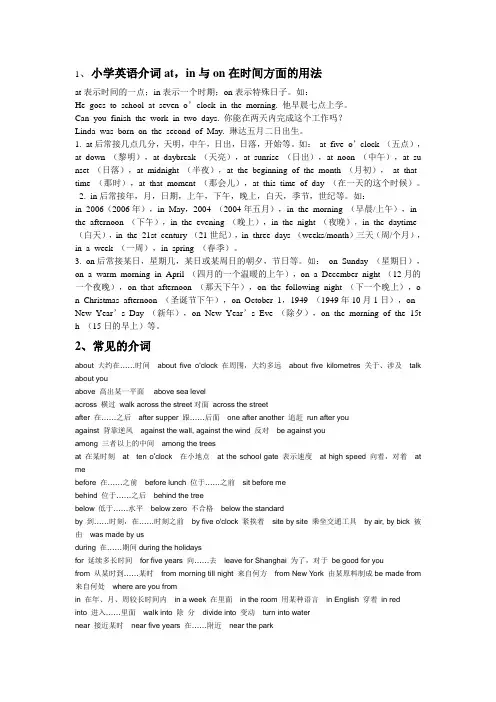
1、小学英语介词at,in与on在时间方面的用法at表示时间的一点;in表示一个时期;on表示特殊日子。
如:He goes to school at seven o’clock in the morning. 他早晨七点上学。
Can you finish the work in two days. 你能在两天内完成这个工作吗?Linda was born on the second of May. 琳达五月二日出生。
1. at后常接几点几分,天明,中午,日出,日落,开始等。
如:at five o’clock (五点),at down (黎明),at daybreak (天亮),at sunrise (日出),at noon (中午),at su nset (日落),at midnight (半夜),at the beginning of the month (月初),at that time (那时),at that moment (那会儿),at this time of day (在一天的这个时候)。
2. in后常接年,月,日期,上午,下午,晚上,白天,季节,世纪等。
如:in 2006(2006年),in May,2004 (2004年五月),in the morning (早晨/上午),in the afternoon (下午),in the evening (晚上),in the night (夜晚),in the daytime (白天),in the 21st century (21世纪),in three days (weeks/month)三天(周/个月),in a week (一周),in spring (春季)。
3. on后常接某日,星期几,某日或某周日的朝夕,节日等。
如:on Sunday (星期日),on a warm morning in April (四月的一个温暖的上午),on a December night (12月的一个夜晚),on that afternoon (那天下午),on the following night (下一个晚上),o n Christmas afternoon (圣诞节下午),on October 1,1949 (1949年10月1日),on New Year’s Day (新年),on New Year’s Eve (除夕),on the morning of the 15t h (15日的早上)等。
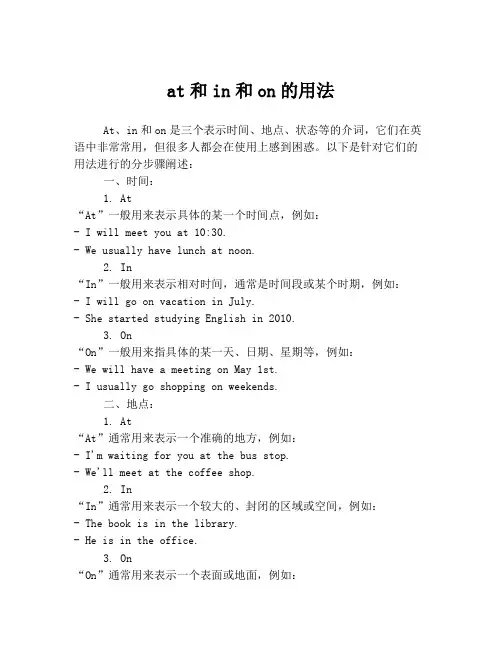
at和in和on的用法At、in和on是三个表示时间、地点、状态等的介词,它们在英语中非常常用,但很多人都会在使用上感到困惑。
以下是针对它们的用法进行的分步骤阐述:一、时间:1. At“At”一般用来表示具体的某一个时间点,例如:- I will meet you at 10:30.- We usually have lunch at noon.2. In“In”一般用来表示相对时间,通常是时间段或某个时期,例如:- I will go on vacation in July.- She started studying English in 2010.3. On“On”一般用来指具体的某一天、日期、星期等,例如:- We will have a meeting on May 1st.- I usually go shopping on weekends.二、地点:1. At“At”通常用来表示一个准确的地方,例如:- I'm waiting for you at the bus stop.- We'll meet at the coffee shop.2. In“In”通常用来表示一个较大的、封闭的区域或空间,例如:- The book is in the library.- He is in the office.3. On“On”通常用来表示一个表面或地面,例如:- The cup is on the table.- The cat is on the bed.三、状态:1. At“At”通常用来表示某个状态或事件的发生,例如:- I was surprised at his sudden appearance.- She was angry at her brother's behavior.2. In“In”通常用来表示人或事物所处的情形或状态,例如:- He is in a bad mood today.- The project is in a critical stage.3. On“On”通常用来表示某个动作或状态的进行,例如:- I am working on my paper.- They are focusing on the task.总结来说,掌握“At、in和on”的使用方法,不仅可以帮助我们更清晰地表述自己的意思,也能有效避免犯语法错误,提高英语表达能力。
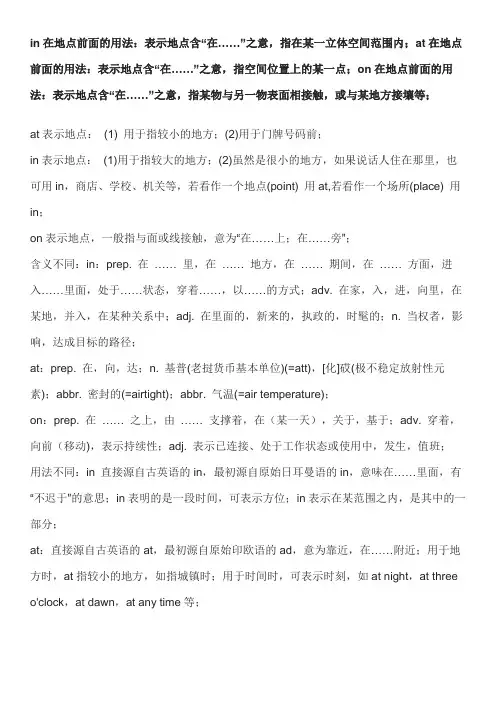
in在地点前面的用法:表示地点含“在……”之意,指在某一立体空间范围内;at在地点前面的用法:表示地点含“在……”之意,指空间位置上的某一点;on在地点前面的用法:表示地点含“在……”之意,指某物与另一物表面相接触,或与某地方接壤等;at表示地点:(1) 用于指较小的地方;(2)用于门牌号码前;in表示地点:(1)用于指较大的地方;(2)虽然是很小的地方,如果说话人住在那里,也可用in,商店、学校、机关等,若看作一个地点(point) 用at,若看作一个场所(place) 用in;on表示地点,一般指与面或线接触,意为“在……上;在……旁”;含义不同:in:prep. 在…… 里,在…… 地方,在…… 期间,在…… 方面,进入……里面,处于……状态,穿着……,以……的方式;adv. 在家,入,进,向里,在某地,并入,在某种关系中;adj. 在里面的,新来的,执政的,时髦的;n. 当权者,影响,达成目标的路径;at:prep. 在,向,达;n. 基普(老挝货币基本单位)(=att),[化]砹(极不稳定放射性元素);abbr. 密封的(=airtight);abbr. 气温(=air temperature);on:prep. 在…… 之上,由…… 支撑着,在(某一天),关于,基于;adv. 穿着,向前(移动),表示持续性;adj. 表示已连接、处于工作状态或使用中,发生,值班;用法不同:in 直接源自古英语的in,最初源自原始日耳曼语的in,意味在……里面,有“不迟于”的意思;in表明的是一段时间,可表示方位;in表示在某范围之内,是其中的一部分;at:直接源自古英语的at,最初源自原始印欧语的ad,意为靠近,在……附近;用于地方时,at指较小的地方,如指城镇时;用于时间时,可表示时刻,如at night,at three o'clock,at dawn,at any time等;on:on表示“在物体的表面上”,而表示“手脚上的斑点”时,应用介词on。
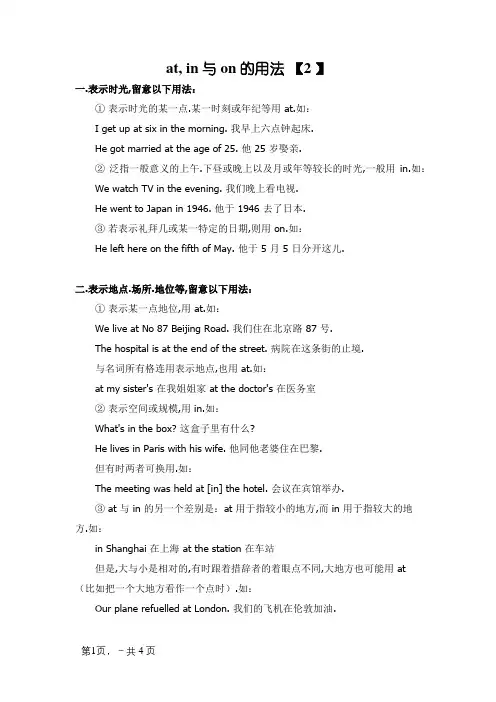
at, in与on的用法【2 】一.表示时光,留意以下用法:①表示时光的某一点.某一时刻或年纪等用 at.如:I get up at six in the morning. 我早上六点钟起床.He got married at the age of 25. 他 25 岁娶亲.②泛指一般意义的上午.下昼或晚上以及月或年等较长的时光,一般用in.如:We watch TV in the evening. 我们晚上看电视.He went to Japan in 1946. 他于 1946 去了日本.③若表示礼拜几或某一特定的日期,则用 on.如:He left here on the fifth of May. 他于 5 月 5 日分开这儿.二.表示地点.场所.地位等,留意以下用法:①表示某一点地位,用 at.如:We live at No 87 Beijing Road. 我们住在北京路 87 号.The hospital is at the end of the street. 病院在这条街的止境.与名词所有格连用表示地点,也用 at.如:at my sister's 在我姐姐家 at the doctor's 在医务室②表示空间或规模,用 in.如:What's in the box? 这盒子里有什么?He lives in Paris with his wife. 他同他老婆住在巴黎.但有时两者可换用.如:The meeting was held at [in] the hotel. 会议在宾馆举办.③ at 与 in 的另一个差别是:at 用于指较小的地方,而 in 用于指较大的地方.如:in Shanghai 在上海 at the station 在车站但是,大与小是相对的,有时跟着措辞者的着眼点不同,大地方也可能用 at(比如把一个大地方看作一个点时).如:Our plane refuelled at London. 我们的飞机在伦敦加油.We stopped for an hour at Moscow on our way to Paris. 我们在去巴黎的途中在莫斯科停了 1 个小时.④介词 on 用于地点,重要指在某物的表面.如:What's on the table? 桌上有什么?There's a wallet lying on the ground. 地上有个钱包.【注】在少数搭配中,也用介词 on.如:He works on a farm. 他在农场工作.三.在某些搭配中,三者的差别与英国英语和美国英语有关:in the street (英) / on the street (美) 在街上in the road (英) / on the road (美) 在路上in the team (英) / on the team (美) 在这个队at the weekend (英) / on the weekend (美) 在周末at weekends (英) / on weekends (美) 在周末四.有时三者的差别与搭配习惯和用法有关:in bed 在床上on the bed 在床上in the tree (多指树外之物) 在树上on the tree (多指树本身之物) 在树上at, in与on的差别一.in,on在方位名词前的差别1. in表示A地在B地规模之内.如: Taiwan is in the southeast of China.2. on表示A地与B地交界.邻接.如: North Korea is on the east of China.二.at, in, on在表示时光上的差别1. at指时光表示:(1)时光的一点.时刻等.如:They came home at sunrise (at noon, at midnight, at ten o’clock, at daybreak, at dawn).(2)较短暂的一段时光.可指某个节日或被以为是一年中标志大事的日子.如:He went home at Christmas (at New Year, at the Spring Festival, at night).2. in指时光表示:(1)在某个较长的时光(如世纪.朝代.年.月.季候以及泛指的上午.下昼或傍晚等)内.如:in 2004, in March, in spring, in the morning, in the evening, etc(2)在一段时光之后.一般情形下,用于未来时,谓语动词为刹时动词,意为“在……今后”.如:He will arrive in two hours.谓语动词为延续性动词时,in意为“在……以内”.如:These products will be produced in a month.留意:after用于未来时光也指一段时光之后,但厥后的时光是“一点”,而不是“一段”.如:He will arrive after two o’clock.3. on指时光表示:(1)具体的时日和一个特定的时光,如某日.某节日.礼拜几等.如:On Christmas Day(On May 4th), there will be a celebration.(2)在某个特定的凌晨.下昼或晚上.如:He arrived at 10 o’clock on the night of the 5th.(3)准时,按时.如:If the train should be on time, I should reach home before dark.三.at, in和on表示地点时的差别1. at表示地点:(1)用于指较小的地方.如: I shall wait for you at the station.(2)用于门商标码前.如: He lives at 115 Zhongshan Road.2. in表示地点:(1)用于指较大的地方.如:He lives in Shanghai.(2)固然是很小的地方,假如措辞人住在那边,也可用in.市肆.黉舍.机关等,若看作一个地点(point)用at,若看作一个场所(place)用in.如:I met him at the post-office.I’m now working in the post-office.3. on表示地点,一般指与面或线接触,意为“在……上;在……旁”.如:The picture was hanging on the wall.New York is on the Hudson River.。
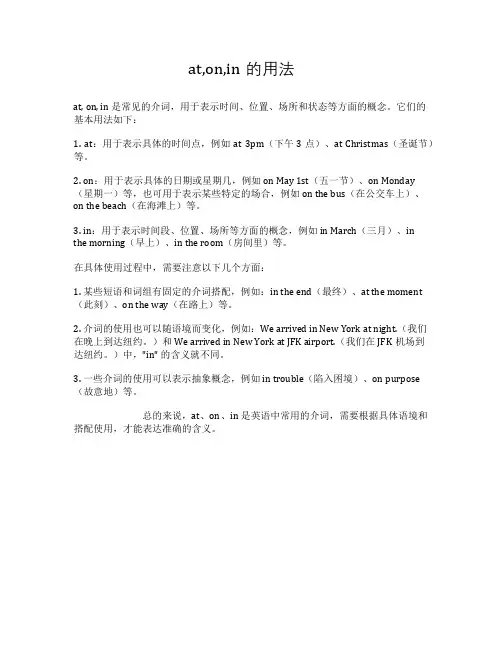
at,on,in的用法
at, on, in 是常见的介词,用于表示时间、位置、场所和状态等方面的概念。
它们的
基本用法如下:
1. at:用于表示具体的时间点,例如at 3pm(下午3点)、at Christmas(圣诞节)等。
2. on:用于表示具体的日期或星期几,例如 on May 1st(五一节)、on Monday
(星期一)等,也可用于表示某些特定的场合,例如 on the bus(在公交车上)、on the beach(在海滩上)等。
3. in:用于表示时间段、位置、场所等方面的概念,例如 in March(三月)、in
the morning(早上)、in the room(房间里)等。
在具体使用过程中,需要注意以下几个方面:
1. 某些短语和词组有固定的介词搭配,例如:in the end(最终)、at the moment (此刻)、on the way(在路上)等。
2. 介词的使用也可以随语境而变化,例如:We arrived in New York at night.(我们在晚上到达纽约。
)和 We arrived in New York at JFK airport.(我们在JFK机场到
达纽约。
)中,"in" 的含义就不同。
3. 一些介词的使用可以表示抽象概念,例如 in trouble(陷入困境)、on purpose (故意地)等。
总的来说,at、on、in 是英语中常用的介词,需要根据具体语境和搭配使用,才能表达准确的含义。
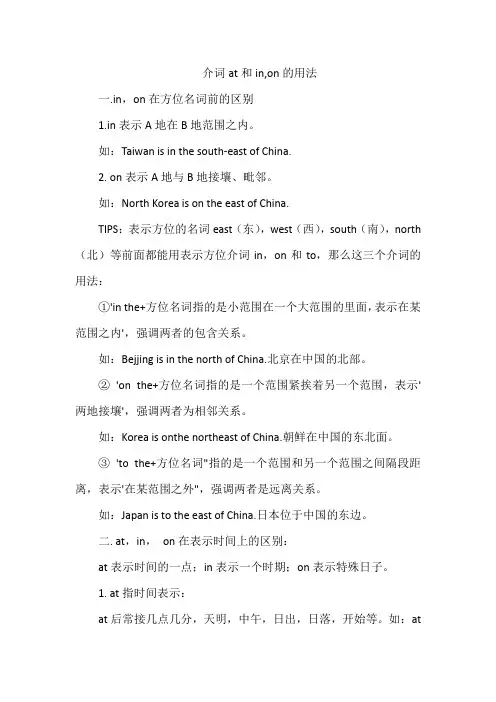
介词at和in,on的用法一.in,on在方位名词前的区别1.in表示A地在B地范围之内。
如:Taiwan is in the south-east of China.2. on表示A地与B地接壤、毗邻。
如:North Korea is on the east of China.TIPS:表示方位的名词east(东),west(西),south(南),north (北)等前面都能用表示方位介词in,on和to,那么这三个介词的用法:①'in the+方位名词指的是小范围在一个大范围的里面,表示在某范围之内',强调两者的包含关系。
如:Bejjing is in the north of China.北京在中国的北部。
②'on the+方位名词指的是一个范围紧挨着另一个范围,表示'两地接壤',强调两者为相邻关系。
如:Korea is onthe northeast of China.朝鲜在中国的东北面。
③'to the+方位名词"指的是一个范围和另一个范围之间隔段距离,表示'在某范围之外",强调两者是远离关系。
如:Japan is to the east of China.日本位于中国的东边。
二. at,in,on在表示时间上的区别:at表示时间的一点;in表示一个时期;on表示特殊日子。
1. at指时间表示:at后常接几点几分,天明,中午,日出,日落,开始等。
如:atfive o' clock(五点),at down(黎明),at daybreak(天亮),at sunrise (日出),at noon(中午),at sunset(日落),at midnight(半夜),at the beginning of the month(月初),at that time(那时),at that moment(那会儿),at this time of day(在一天的这个时候)。
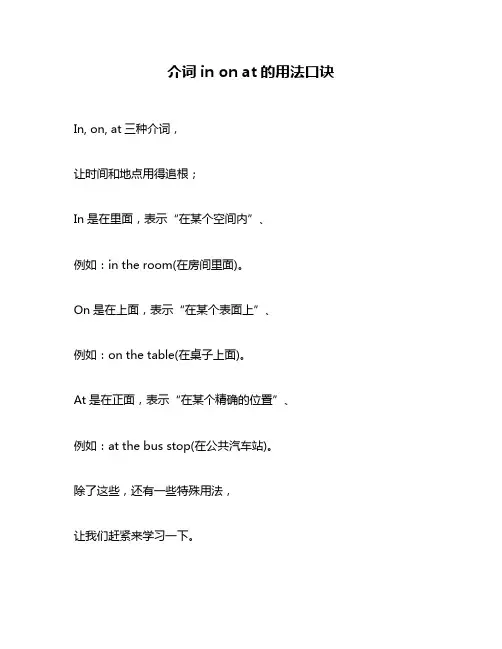
介词in on at的用法口诀In, on, at三种介词,
让时间和地点用得追根;
In是在里面,表示“在某个空间内”、
例如:in the room(在房间里面)。
On是在上面,表示“在某个表面上”、
例如:on the table(在桌子上面)。
At是在正面,表示“在某个精确的位置”、
例如:at the bus stop(在公共汽车站)。
除了这些,还有一些特殊用法,
让我们赶紧来学习一下。
In用于在一段时间的中间,
例如:in the morning(在早晨);On用于在某一天或某一个日期上,例如:on Monday(在星期一);
At用于在具体的时间上,
例如:at 9 o'clock(在9点钟)。
注意,at还用于场所,如:
at school(在学校)、at home(在家)。
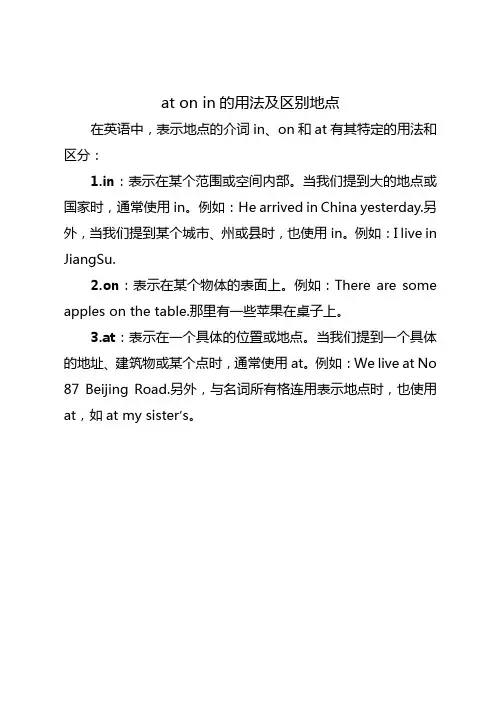
at on in的用法及区别地点
在英语中,表示地点的介词in、on和at有其特定的用法和区分:
1.in:表示在某个范围或空间内部。
当我们提到大的地点或国家时,通常使用in。
例如:He arrived in China yesterday.另外,当我们提到某个城市、州或县时,也使用in。
例如:I live in JiangSu.
2.on:表示在某个物体的表面上。
例如:There are some apples on the table.那里有一些苹果在桌子上。
3.at:表示在一个具体的位置或地点。
当我们提到一个具体的地址、建筑物或某个点时,通常使用at。
例如:We live at No 87 Beijing Road.另外,与名词所有格连用表示地点时,也使用at,如at my sister’s。
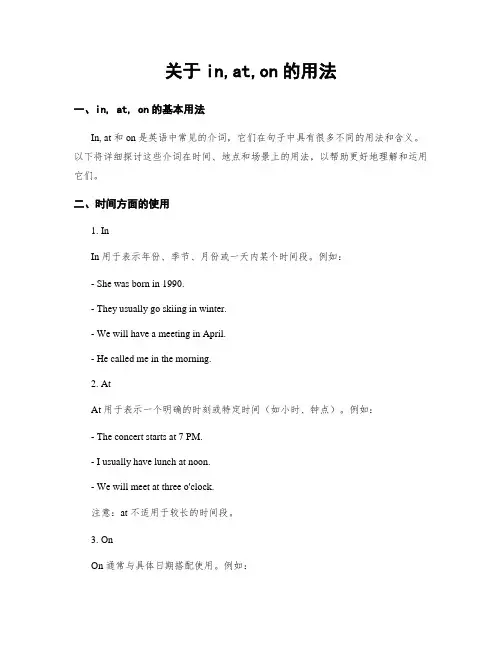
关于in,at,on的用法一、in, at, on的基本用法In, at 和 on 是英语中常见的介词,它们在句子中具有很多不同的用法和含义。
以下将详细探讨这些介词在时间、地点和场景上的用法,以帮助更好地理解和运用它们。
二、时间方面的使用1. InIn 用于表示年份、季节、月份或一天内某个时间段。
例如:- She was born in 1990.- They usually go skiing in winter.- We will have a meeting in April.- He called me in the morning.2. AtAt 用于表示一个明确的时刻或特定时间(如小时、钟点)。
例如:- The concert starts at 7 PM.- I usually have lunch at noon.- We will meet at three o'clock.注意:at 不适用于较长的时间段。
3. OnOn 通常与具体日期搭配使用。
例如:- Our anniversary is on June 15th.- The party is on Saturday.同样,on 不适用于较长的时间段。
三、地点方面的使用1. InIn 表示相对较大范围的区域或地点。
例如:- She lives in Canada.- There are beautiful beaches in Hawaii.2. AtAt 表示一个具体位置或特定场所。
例如:- Meet me at the park after school.- He works at a hospital.3. OnOn 常用于具体的物体表面或较小范围的地点。
例如:- The book is on the table.- There is a pen on his desk.四、场景方面的使用1. InIn 表示在某种情境或状态中。
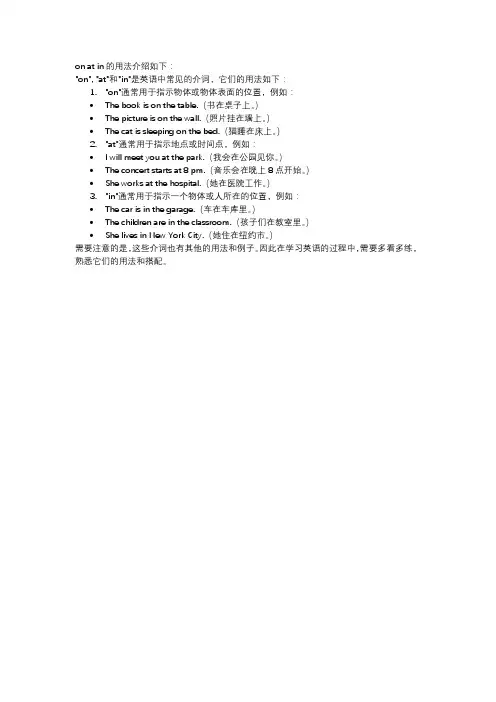
on at in的用法介绍如下:
"on", "at"和"in"是英语中常见的介词,它们的用法如下:
1."on"通常用于指示物体或物体表面的位置,例如:
•The book is on the table.(书在桌子上。
)
•The picture is on the wall.(照片挂在墙上。
)
•The cat is sleeping on the bed.(猫睡在床上。
)
2."at"通常用于指示地点或时间点,例如:
•I will meet you at the park.(我会在公园见你。
)
•The concert starts at 8 pm.(音乐会在晚上8点开始。
)
•She works at the hospital.(她在医院工作。
)
3."in"通常用于指示一个物体或人所在的位置,例如:
•The car is in the garage.(车在车库里。
)
•The children are in the classroom.(孩子们在教室里。
)
•She lives in New York City.(她住在纽约市。
)
需要注意的是,这些介词也有其他的用法和例子。
因此在学习英语的过程中,需要多看多练,熟悉它们的用法和搭配。
in ,on, at用法in,on,at是英语中常见的介词,它们在句子中通常用来表示时间、地点等。
它们的用法虽然有些相似,但也有不同之处,下面将详细介绍它们的用法。
1. in的用法:表示时间:用在表示“年、季节、月份、长时间段”的时间词前。
例如:in 2021,in summer,in March,in a week。
表示地点:用在表示“大的区域、国家、城市、建筑物”的名词前。
例如:in China,in New York,in the park。
表示状态或情况:用在表示“状态或情况”的名词前。
例如:in trouble,in a hurry。
2. on的用法:表示时间:用在表示“星期、某一天、具体的日期”的时间词前。
例如:on Monday,on September 1st,on the weekend。
表示地点:用在表示“表面、街道、楼层、交通工具”的名词前。
例如:on the table,on the street,on the 4th floor,on the bus。
表示方式或情况:用在表示“方式或情况”的名词前。
例如:on foot,on fire。
3. at的用法:表示时间:用在表示“具体的时间点”的时间词前。
例如:at 8 o'clock,at noon,at midnight。
表示地点:用在表示“具体的地点、建筑物”的名词前。
例如:at home,at the airport,at the cinema。
表示活动或事件:用在表示“活动或事件”的名词前。
例如:at a party,at a concert。
总的来说,in表示范围、时间长、状态等;on表示表面、最上层、交通工具等;at表示具体的时间、地点、事件等。
要根据具体语境选择合适的介词。
at,in,on,的用法使用介词(prepositions)是英语中必不可少的一部分。
其中,at、in和on这三个介词常用于表达时间、地点和其他相关概念。
在本文中,我们将详细了解这些介词的用法及其区别。
一、at的用法:1. 表示具体时间点:- I have a meeting at 9 AM tomorrow.- Let's meet at the restaurant at 7 PM.2. 表示特定地点:- She works at a hospital.- They are waiting for us at the bus stop.3. 表示活动或事件:- I am good at playing the piano.- He laughed at the joke.4. 表示价格或速度:- The book is on sale at $10.- The car was driving at 100 miles per hour.二、in的用法:1. 表示在某个范围或内部:- She lives in New York City.- We will be there in a few minutes.2. 表示季节、月份或年份:- I love hiking in spring.- My birthday is in October.3. 表示领域、行业或类别:- He works in finance.- She studies in the medical field.4. 表示状态或情况:- They are in love with each other.- He is currently in a meeting.三、on的用法:1. 表示具体日期和星期几:- The party is on Friday night.- I have an appointment with the doctor on June 10th.2. 表示在面向上方的表面或位置:- The book is on the table.- The picture hangs on the wall.3. 表示通过某种交通工具:- I travel to work on the bus.- She went to the party on her bike.4. 表示接触或处理某事:- I am working on my presentation.- He is focusing on his studies.综合比较这三个介词的用法可以得出以下总结:1. at用于表示具体时间点、特定地点、活动或事件以及价格或速度。
at in on的用法at, in, on的用法一、概述在英语中,介词是非常重要的一部分语法成分,它们用于表示名词与其他词或短语之间的关系。
这篇文章将重点介绍三个常见的介词:at、in和on,并详细讨论它们在句子中的具体用法。
二、at的用法1. 表示地点at常用来表示一个特定的地点,例如:- I will meet you at the park.我会在公园和你见面。
- She works at a restaurant.她在一家餐馆工作。
注意,当所指地点是机构、公司或建筑物时,通常使用at。
而对于城市、国家或岛屿等地名,则需要使用in。
2. 表示具体时间at也可用来表示一个具体的时间点,例如:- The meeting starts at 9 o'clock.会议从九点开始。
- I usually have lunch at noon.我通常在中午吃午饭。
不过,在表达某种时间段时,通常会使用in而不是at。
3. 表示活动at还可用来表示某些活动、事件或行为,例如:- They laughed at his joke.他们笑了他的笑话。
- Don't be surprised if people stare at you.如果有人盯着你看,请不要感到惊讶。
三、in的用法1. 表示地点in常用来表示一个较大的区域或地方,例如:- She lives in New York City.她住在纽约市。
- The book is in my bag.书在我的包里。
通常,当所指地点是某个特定的建筑物或机构时,应使用at。
2. 表示时间段in通常用于表示一段持续的时间,在以下情况下使用:- She will graduate in two years.她将在两年后毕业。
- I have a meeting in the afternoon.我下午有个会议。
但是,在表示具体的时间点时,应使用at而不是in。
in at on介词的用法一、介词in的用法1. 表示位置介词"in"可以用来描述某物或某人在一个地点的内部或范围之中。
例如:- The cat is in the box.(猫在盒子里)- The books are in the library.(书在图书馆里)2. 表示时间介词"in"也可用于表示某个时间段或特定的时刻。
例如:- We usually have a meeting in the morning.(我们通常在早上开会)- She was born in July.(她出生在七月)3. 表示状态或条件当涉及到某种状况或情况时,介词"in"可以使用。
例如:- He is in good health.(他身体很健康)- You are in trouble now.(你现在有麻烦了)4. 表示参与活动或工作领域介词"in"还可用来表达参与某项活动或从事某个领域的工作。
例如:- She is interested in playing tennis.(她对打网球感兴趣)- He works in the IT industry.(他从事IT行业)二、介词at的用法1.表示地点介词"at"经常被用来指明准确的位置。
例如:- I am waiting for you at the bus stop. (我正在公交车站等你)- Let's meet at the coffee shop. (我们在咖啡店见面)2.表示特定的时间介词"at"用于表示具体的时刻。
例如:- We have an appointment at 3 o'clock.(我们有一个3点钟的约会)- The concert starts at 7:30 PM.(音乐会晚上7:30开始)3.表示某种状态或情况有时候,介词"at"也可以用来描述某种状态或情况。
介词at,in与on的用法与区别介词at、in与on的用法与区别介词作为一种常见的词类,用于连接不同的词与词组,起到连接业务的作用。
英语中有很多介词,其中at、in与on是使用频率非常高的三个介词。
它们在使用中有一些相似之处,但也有一些不同之处。
本文将重点介绍at、in与on的用法与区别。
一、at的用法与区别1. 表示具体位置或地点at一般用于表示精确的位置或地点,强调在某个具体的地方。
比如:- She is waiting for you at the bus stop.(她正在公交车站等你。
)- The party will be held at his house.(聚会将在他家举行。
)2. 表示具体时间at也可用于表示具体的时间点。
比如:- We will meet at 10:00.(我们将在10点见面。
)- He usually has dinner at 7:30.(他通常在7点30分吃晚饭。
)3. 表示活动或事件at可以用于表示某个活动或事件。
比如:- I'm good at playing basketball.(我擅长打篮球。
)- She is laughing at the joke.(她正在笑这个笑话。
)二、in的用法与区别1. 表示位置或地点in通常用于表示一个相对较大的范围,比如国家、城市、街道等。
比如:- I live in China.(我住在中国。
)- The museum is in London.(博物馆在伦敦。
)2. 表示时间段in也可以表示一个具体的时间段。
比如:- He will arrive in an hour.(他将在一个小时后到达。
)- The project will be completed in two weeks.(这个项目将在两周内完成。
)3. 表示状态或条件in还可以用于表示某种状态或条件。
比如:- The flowers are in full bloom.(花开得很盛。
1)in 把地方、地点、位置当作一个范围或一个封闭的空间:
1. I live in Beijing. 我住在北京。
(大城市用in)
2. I live in England, at London. 我住在英国伦敦。
(England大过London喔)
3. I live in a big city, my brother lives at a small town. 我住在大城市,我
哥哥住在一个小市镇。
(如果把city看做一个圆圈,small town就成一个点。
因此就in
a city, at a small town. 呵呵)
4. We have a meeting in Beijing. 我们有北京有一个会议。
5. Mars is in the Solar System. 火星在太阳系里。
6. in a car 乘汽车(不是on a car 也不是by a car 喔)
7. in a taxi 乘的士(不是on a taxi 或by a taxi )
8. in a helicopter 乘直升机
9. in a boat 乘小船
10. in a lift (elevator) 乘电梯(电梯像个笼子,当然要用in 啦)
11. in the newspaper 在报上
12. in the sky 在空中
13. in the bed 在床上(也可用on the bed)
14. in the bedroom/ class/ library/ school 在寝室/课室/图书馆/学校
.
2).at 把地方、地点、位置当作一个“点”:
1. The begger is sitting at the corner. 那乞丐坐在角落里。
2. Jane is waiting for you at the bus stop. Jane在巴士站等你。
3. at home 在家
4. Who's standing there at the door? 谁站在门口?
5. at the top of the page 在一页的上面
6. The shop is at the end of the road. 那商店就在路的尾端。
7. at the entrance 在进口处
8. at the crossroads 在十字路口
9. When will you arrive at the office? 你什么时候会到公司呢?
10. I'm in France, at Paris. 我住在法国巴黎。
(相对法国来讲,巴黎只是一个
“点”)
11. There is a small hut at the foot of the hill. 山脚下有一座小屋子。
12. My aunt lives at 55 Boretz Road in Durham.
我的姑妈住在Durham,Boretz 路门牌55号。
(地址要用at,不能用in)
13. at the side 在一边
14. at reception 在招待会上
15. I'm at work. 我在工作。
16. at class/ home/ the library/ the office/ school 在班上/家里/图书馆/公
司/学校
(3). on 把地方、地点、位置当作一个平面:
1. The author's name is on the cover of the book. 在书的封面上有作者的名
字。
2. There are no prices on this menu. 在这菜单上没有价钱。
3. Y ou are standing on my foot. 你踏到我的脚了。
4. There was a "no smoking" sign on the wall. 在那墙上有个“不准吸烟”的牌
子。
5. I live on the 7th floor at 21 Oxford Street in London. 我住在伦敦牛津街
21号八楼。
(7th floor 就是八楼;注意句中的on, at, in 的用法)
6. on a bus 乘巴士(不是in a bus 喔)
7. on a train 乘火车(可想像“骑”在火车上,哈哈)
8. on a plane 乘飞机(可想像“骑”在飞机上)
9. on a ship 乘轮船
10. on a bicycle, on a motorbike 骑自行车/摩托车
11. on a horse, on an elephant 骑马/象
12. on the radio, on television 听广播、看电视
13. on the left, on the right 在左边、在右边
14. on the way 在路上
15. on the bed 在床上(也可用in the bed)
16. on the ceiling 在天花板上
17. on the floor 在地板上
on,at,in用法巧记
on,at,in这三个常用介词都可以表示时间和地点,但具体用法不同,多数学生对它们混淆不清。
现在只要记住了口诀,就可避免at,on,in的种种误用。
1. on,in,at表示时间
on“在具体某一天”①
“当某时”,动名词,arrival,death前;early,late位句先②,用in一般“上”“下”“晚”;on 用于天,in用于月、季、年③;限定三时in要变。
④at是个时间点,“工作”“时刻”与“圣诞”⑤。
at noon(night),in the day,习惯用语记心间。
注:①on表示在具体某一天及具体某一天的上午、下午和晚上。
例On mother's Day, we should send flowers to our mother. 母亲节,我们应该送花给我们的母亲。
On my arrival home,I found he had gone already.当我到家时,我发现他已经走了。
②当early,late用于句首修饰介词短语时,尽管表示具体某一天的上午、下午、晚上,都要用in,泛指一般的上、下午,晚上也用in 。
例Early in the morning of National Day,I got up to catch the first bus to the zoo.国庆节一清
早,我便起床去赶到动物园的第一班公共汽车。
My father begins work at 8:00 in the morning and stops work at 4:00 in the afternoon.我父亲上午8点上班,下午4点下班。
③于将来时态表示“过一段时间后” 及表示“在……期间” 和“在某个季节,某年、某月” 都用in。
例I hear he’ll be back in a month.我听说他将于一个月后回来。
In the course of the last lesson in French,little Franz was listening to the master very attentively.在那最后一堂法语课中,小弗朗兹非常用心地听着老师讲。
Xiao Ming was born in December of 2004. 小明生于2004年12月。
④当morning,afternoon,evening有前位定语或后置定语限定时,就不用in而用on。
例on a hot (summer) noon 在一个炎热(夏天)的中午
on Monday morning 在星期一上午
on the morning of March 8th在3月8日上午
⑤表示某时某刻及在work,Christmas前用at。
例We get up at eight o’clock.我们8点起床。
My father are busily at work all day.我父亲整天忙于工作。
In western countries children get present from their parents at Christmas.在西方国家,孩子们在圣诞节得到父亲给的礼物。